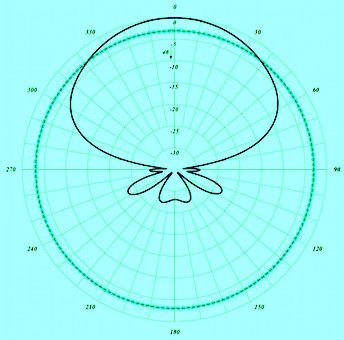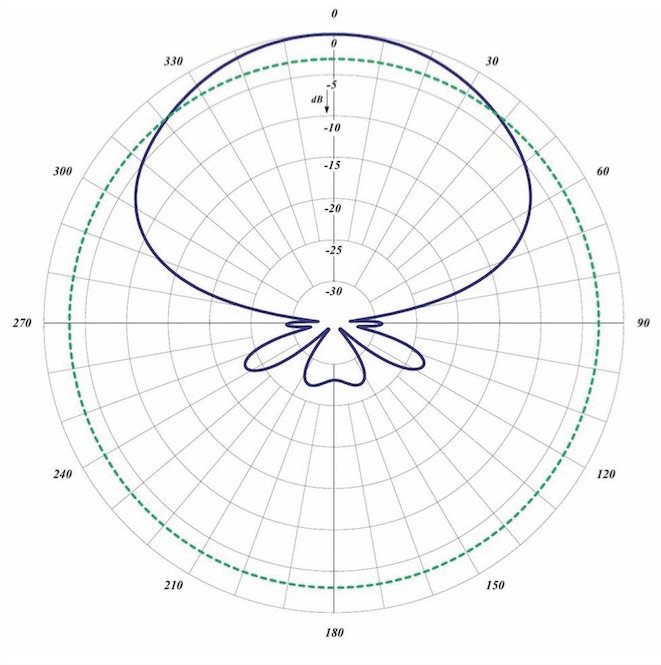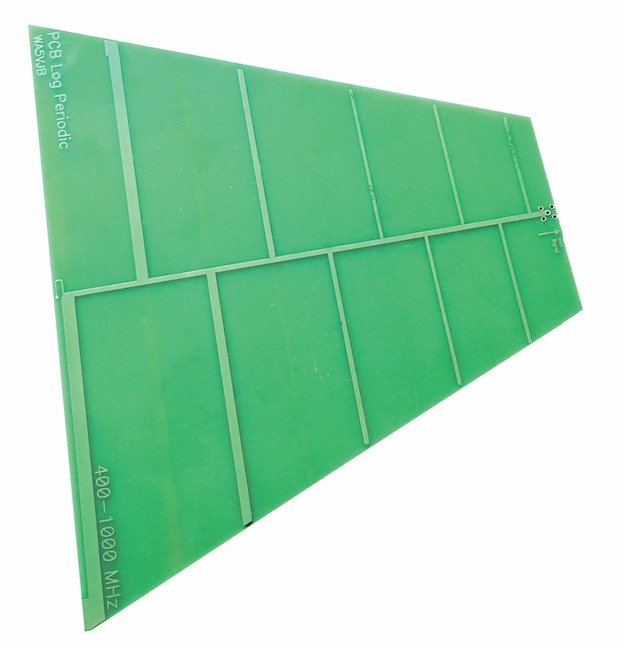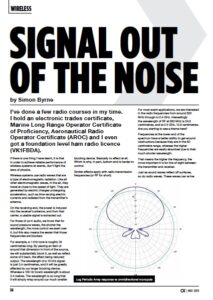News
30 May 2019
Signal out of the Noise

Subscribe to CX E-News
WIRELESS
Signal out of the Noise
by Simon Byrne.
I’ve done a few radio courses in my time. I hold an electronic trades certificate, Marine Long Range Operator Certificate of Proficiency, Aeronautical Radio Operator Certificate (AROC) and I even got a foundation level ham radio licence (VK1FBDA).
If there is one thing I have learnt, it is that in order to achieve reliable performance of wireless systems at events, don’t fight the laws of physics.
Wireless systems use radio waves that are a type of electromagnetic radiation. Like all other electromagnetic waves, in the air, they travel at close to the speed of light. They are generated by electric charges undergoing acceleration, such as time varying electric currents and radiated from the transmitter’s antenna.
On the receiving end, the power is induced into the receiver’s antenna, and from that carrier, a usable signal is extracted out.
For those of us in audio, we know that for sound pressure waves, the shorter the wavelength, the more control we exert over it, but this also means the easier that those frequencies are blocked. For example, a 1 kHz tone is roughly 34 centimetres long. By placing an item of around that dimension in front of the source, we will substantially block it, as well as reflect some of it back, the effect being reduced output.
The wavelength of a 10 kHz signal is just 3.4 centimetres, and it will be greatly affected by our larger blocking device. Whereas a 100 Hz tone’s wavelength is about 3.4 metres. The wavelength is so long that it will simply wrap around our much smaller blocking device.
Basically no effect at all. Which is why, in part, bottom end is harder to control. Similar effects apply with radio transmission frequencies (or RF for short).
For most event applications, we are interested in the radio frequencies from around 520 MHz through to 2.4 GHz. Interestingly the wavelength of RF at 550 MHz is 54.5 centimetres, and at 2.4 GHz, 12.5 centimetres.
Are you starting to see a theme here? Frequencies at the lower end of the spectrum have a better ability to get around obstructions because they are in the 50 centimetre range, whereas the higher frequencies are easily absorbed due to their much shorter wavelength.
That means the higher the frequency, the more important it is for line of sight between the transmitter and receiver. Just as sound waves reflect off surfaces, so do radio waves. These waves can arrive via multiple, and different length paths which contributes to phase cancellation.
By getting the receive antennas up high, as well eliminating line of sight blockages, you can reduce the relative strength of the reflected waves because they then have to travel further in relation to the direct wave.
Whilst talking line of sight, the human body will soak up as much as 50% of the radiated power from a wireless beltpack. That being the case, having the receive antennas up high, and in a location where clear line of sight of the transmitter beltpacks, that is, behind the performers if need be, dramatically improves reliability.
In a free field, the inverse square law can apply to RF too, so use it to your advantage.
Say your receiver is side stage, 10 metres away from the talent. Through poor planning, another transmitter is on the exact same frequency in the next room, 100 metres away. By definition the rogue transmitter will be down about 20dBm, or 1/100th the power at the side stage receiver! Not ideal, but you’d get away with this.
But say you put the receiver at front of house so it is 25 metres from the microphone on stage. The ratio between the two transmitters is now only 4:1, so the difference in power is 12dBm. Definitely at risk of interference!
Antenna manufacturers talk of gain. Unless they incorporate active circuitry, antennas don’t have gain in the way a mic preamp does. Antenna gain refers more to an antenna’s directivity. That is enhanced in a particular direction; the greater the gain of the antenna in that direction.
Gain describes the ability of the antenna to receive signals preferentially from certain directions. Gain does not create additional power beyond that delivered by the feed line — it only focuses that energy. I like to think of directional antennas as cardioid antennas. That is, they pick up from the front, but not so much from the sides or the back.
Whereas an omnidirectional antenna will pick up equally from all directions which in most cases means the signal to noise will be lower because noise is being received from all directions.
An ideal use case is LED screens which emit electromagnetic radiation. By using directional antennas, you can null out a lot of the energy from the screens, which means you have increased the signal to noise. You could not do this with an omnidirectional antenna.
Do you need to use active gain? Maybe, maybe not.
We are interested in a strong signal, relative to the noise floor. Radio receivers are quite sensitive so as long as there is a signal significantly higher than the noise floor, you are OK. Therefore if you put an RF amplifier in the circuit, you are raising all the signals received, as well as the noise floor by the exact same amount.
You run the risk of overloading the front end of your receivers. Therefore the primary reason to have active gain is to account for loss in the signal path, especially the cabling between the receive antennas and the receivers. I’ve been advocating to get the antennas up high and to aim them so there is always line of sight to the transmitter, not being blocked by humans so you have to use coaxial cables.
All coax cables used in RF environments have loss, so you need to work our whether the losses are acceptable.
The higher the frequency, the greater the loss per metre. At 600 Mhz, standard RG58 cable will lose about 5 dB per 10 metres which is quite a lot. You definitely want active RF amplifiers at the head of that circuit. However, by using high quality, low loss LMR400 coax that loss is reduced to about 1dB per metre.
You can usually buy LMR 400 by the metre from two-way radio communications suppliers. Importantly, you never want to remotely locate the monopole 1/4 wave antenna’s that are designed to be attached directly to receivers. They rely on a ground plane which is provided by the case of the receiver itself.
Log periodic antennas, or paddles are usually the best solution for remote antennas and for difficult applications. RF Venue have some superb special application antennas. You can make some high performance paddles yourself by buying the Kent Electronics printed circuit board antennas.
These are circuit boards that you simply fit mounting hardware and connectors to, paint them black and you have some very respectable and dirt cheap paddles.
A major emerging culprit for reduced range of wireless microphones is LED lamps in house lighting. As incandescent lamps are replaced with LEDs, they incrementally contribute RF noise thereby raising the venue’s RF noise floor.
Lastly, I generally feel that there needs to be a compelling reason to use wireless. Devices connected by cables will always be more reliable, so if it doesn’t need to be on wireless, don’t.
Useful Links:
RF Venue
High quality antennas and accessories for wireless used in production
www.rfvenue.com
Kent Electronics
Low cost printed circuit board log periodic antenna circuit boards
http://www.wa5vjb.com/products1.html
CX Magazine – May 2019 Entertainment technology news and issues for Australia and New Zealand – in print and free online www.cxnetwork.
© CX Media
Further reading from CX Magazine’s Wireless Feature – May 2019:
Shure Reveal Twinplex. Mission: Take on DPA – by Julius Grafton
Wireless Voodoo – Not a Dark Art – by Fraser Walker
In-Ear Monitoring – by Sennheiser’s Adam Karolewski
Clear-Com FreeSpeak II – by The P.A. People’s Chris Dodds
Signal Out of the Noise – by Simon Byrne
Is that a wireless intercom in your pocket? – by Jand’s Jeff MacKenzie
Antennas for Wireless Microphones – by Jand’s Jeff MacKenzie
The Politics of Wireless – by Simon Byrne
Wireless Recordings – by Andy Stewart
From the archive – Wireless Mics were a feature in Connections Magazine, March 1999: Radio Microphones (Sub-titled “How Did I Get Stuck With This Job!”) by John Matheson (includes a wireless systems Buyers Guide and Radio Spectrum Guide for Australia)
Subscribe
Published monthly since 1991, our famous AV industry magazine is free for download or pay for print. Subscribers also receive CX News, our free weekly email with the latest industry news and jobs.







